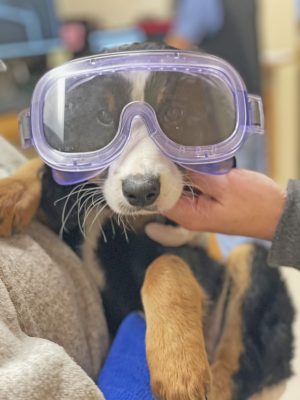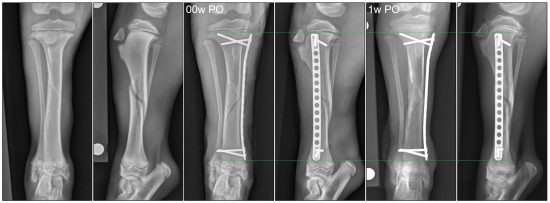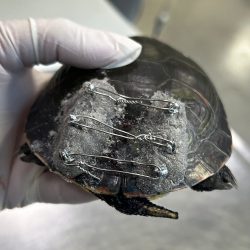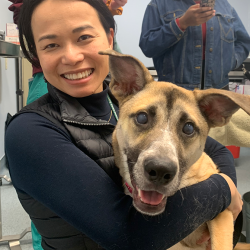
Life is typically fun and games when you’re a puppy. Constant snuggles, training treats, and excitement. Some puppies even have fur siblings that add to this blissful mix. For Lilah, the 11-week-old, 12-pound Bernedoodle, play time with her 90-pound pack mate, Stella, was the time of her life. That was until she not-so-gracefully—as puppies often do—wiggled underneath Stella and got herself stepped on mid-play party time.
“I knew her leg was broken,” says Lilah’s owner. Into the car and to the vet they went. Sure enough, little Lilah had a right tibial fracture. She left her vet donning a splint and bandage, and with a referral to the Michigan State University Orthopedic Surgery Service. In order for her leg to heal properly, Lilah needed surgery.
“When I realized how serious the fracture was, I panicked,” says Lilah’s owner. “Finding out that MSU was able to perform the surgery and make Lilah comfortable made me feel so relieved. Plus, I received two different recommendations to bring Lilah to MSU. Those were the ticket for me.”
Once at MSU, an orthopedic assessment was performed by Dr. Danielle Marturello, attending faculty for the service, and Dr. Brea Sandness, surgery resident. The bandage was removed, at which point it was clear that Lilah’s right tibia was unstable. That’s when Lilah’s veterinary healthcare team collected additional radiographs of both tibiae for surgical planning. Lilah’s break occurred diagonally across the bone, resembling a corkscrew or winding staircase. This type of break has the potential to continue to displace, due to acting forces at the site, and with the already unstable nature of the break on examination, surgery was recommended. As with all injuries that require surgery, for humans or animals, the options are discussed and weighed by the doctor and patient/owner.

“The first option was to replace the splint and not perform surgery. The second option was surgery,” says Marturello. “Since Lilah’s such a young puppy, she was expected to heal quickly with the splint. However, the instability of the fracture gave us concern for continued displacement, and Lilah’s bone healing in an abnormal position if this happened. At MSU, we’re fortunate to have the option to perform surgeries using minimally invasive techniques, which have been shown to expedite healing.”
Given the type of break, Lilah’s age, and the expertise available, the MSU Orthopedic Surgery team recommended the minimally invasive procedure. “This option gave Lilah the best chance to return to normalcy post-surgery. There also were reduced likelihoods of post-surgical complications, like arthritis or improper healing,” says Lilah’s owner. “Overall, the surgery was the best option for a pup of her age to have as normal of a life as possible moving forward.”
For the procedure, Lilah was placed under general anesthesia and underwent elastic plate osteosynthesis (EPO) using minimally invasive techniques. With the help of intra-operative X-rays (fluoroscopy), remote incisions were made at the top and bottom of the bone so that screws could be placed. With the EPO technique, it’s less likely for the screws to back out (which is common in young, soft bones) because they are placed in a diverging fashion. Healing also is expected to proceed quicker since a more flexible plate is used.
“With the EPO technique, it’s less likely for the screws to back out, which is common in young bone due to its softness. Healing also is expected to proceed quicker,” says Marturello. “Indeed, Lilah’s fracture healed in a matter of 6 days and 18 hours!”
Lilah’s owner can attest to this. “Within a week, Lilah was trying to leap around—as if the broken leg never happened. She healed incredibly fast. I have to attribute a portion of the speedy recovery to the amazing care taken by the professionals at MSU.”
Thank you, thank you, and thank you again. Our pets are our family and you treated them as such. The same care was shared with me! —Lilah's owner
Follow-up radiographs revealed that Lilah’s fracture had healed without complications, and that Lilah was continuing to grow normally, as expected.
“My overall experience was phenomenal. Both doctors, Danielle and Brea, were very informative and kept me up to date, step by step. Because of this, I worried less and knew Lilah was in the best hands possible. They were kind, warm, and friendly. I couldn’t ask for a better experience,” adds Lilah’s owner.
To Drs. Marturello and Sandness: “Thank you, thank you, and thank you again. Our pets are our family and you treated them as such. The same care was shared with me! The confidence you and your team had in Lilah and her case was very reassuring. Please know that you are the best of the best and we appreciate every step you took to help us along the way.”



